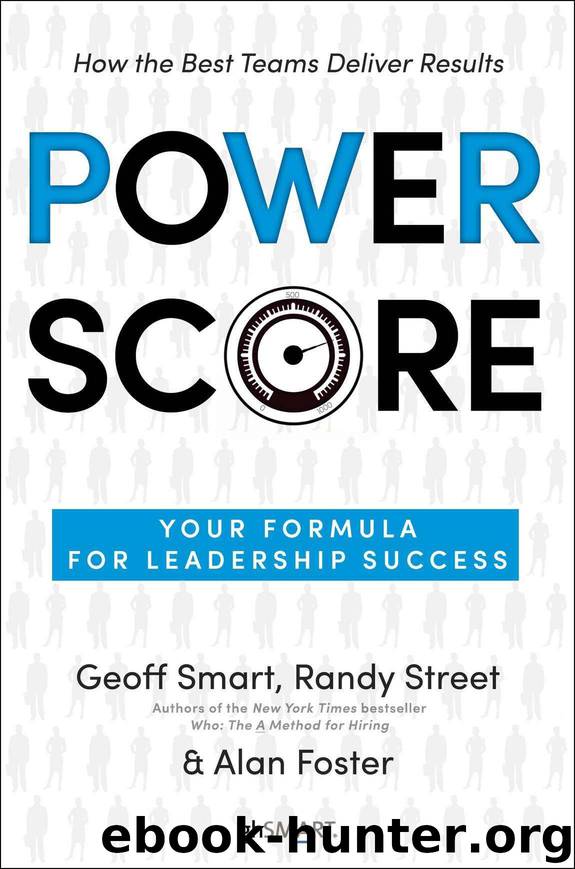Power Score: Your Formula for Leadership Success by Smart Geoff & Street Randy & Foster Alan

Author:Smart, Geoff & Street, Randy & Foster, Alan [Smart, Geoff]
Language: eng
Format: azw
ISBN: 9780345547354
Publisher: Random House Publishing Group
Published: 2015-06-16T04:00:00+00:00
How do the 9’s and 10’s do this?
Verne Harnish of Gazelles does it through a weekly huddle. His team is truly global. “They are all independent entrepreneurs from across twelve and a half time zones around the world who come together to help Gazelles,” Verne said. “Our Monday morning huddle lets us tackle the big issues and challenges for the week.”
The first thing he does during these calls is check in with everybody. Rome may be burning, but they still take a moment to go around and share a piece of good news personally and professionally with one another.
Wouldn’t that take a lot of time away from a critical meeting?
To the contrary, it helps bring everybody together. As Verne said, “Leadership is really about connecting with people as human beings and not as inputs into a managerial process. The check-in is really critical.”
After the check-in, they discuss, debate, and decide on two or three big topics. “We don’t put off specific decisions that need to be made. If we want to move faster, we need to pulse faster.”
Discuss, debate, decide. I like that.
You can use it if you want. We call it 3D at ghSMART—as in, “Let’s 3D this issue.”
Anyway, at the end of Verne’s meetings, everyone gets a chance to check out with a concluding remark, and then they review the next steps. “It’s not micromanagement,” Verne said. “It is great management.”
I like the huddle, but how do I keep my meetings from devolving into boring status updates?
Atul Gawande’s management meetings were typical progress updates. His team showed up, and they took turns to share where their projects were ahead, on track, or behind. Atul would help problem-solve if needed, but everyone was bored out of their minds, including Atul.
Interesting discussions rarely happened. Atul considered getting rid of the meeting altogether. It would have been a popular decision initially, but it also meant that projects might slip and the teams would be unaware of their overlaps.
Instead, Atul and his team decided to blow up the agenda. Rather than share project status, everyone now has to submit a tough question they are grappling with and their recommended solution. The meetings transformed almost overnight from boring status reports to engaging problem-solving sessions.
“Now we have to prepare for meetings,” one of his teammates told us, “but it is worth it.” One subtle shift in the agenda transformed the entire thing.
What about some other ways to coordinate?
It’s worth focusing on Atul for a moment longer because he popularized an incredibly important way to coordinate people, which he outlines in his book The Checklist Manifesto.
Atul discovered that the simple act of putting key actions into a checklist ensured that the right people had the right conversations at the right times. It’s a universal best practice of leadership across many industries, from medicine to airlines to investing to hiring.
For example, Atul described how asking some simple questions before an operation starts—such as “Have all team members introduced themselves by name and role?” “How much blood
Download
This site does not store any files on its server. We only index and link to content provided by other sites. Please contact the content providers to delete copyright contents if any and email us, we'll remove relevant links or contents immediately.
Hit Refresh by Satya Nadella(8854)
The Compound Effect by Darren Hardy(8508)
Change Your Questions, Change Your Life by Marilee Adams(7372)
Nudge - Improving Decisions about Health, Wealth, and Happiness by Thaler Sunstein(7242)
The Black Swan by Nassim Nicholas Taleb(6763)
Deep Work by Cal Newport(6563)
Daring Greatly by Brene Brown(6222)
Rich Dad Poor Dad by Robert T. Kiyosaki(6174)
Principles: Life and Work by Ray Dalio(5961)
Man-made Catastrophes and Risk Information Concealment by Dmitry Chernov & Didier Sornette(5646)
Playing to Win_ How Strategy Really Works by A.G. Lafley & Roger L. Martin(5498)
Digital Minimalism by Cal Newport;(5389)
Big Magic: Creative Living Beyond Fear by Elizabeth Gilbert(5351)
The Myth of the Strong Leader by Archie Brown(5237)
The Slight Edge by Jeff Olson(5200)
Discipline Equals Freedom by Jocko Willink(5157)
The Motivation Myth by Jeff Haden(5003)
Stone's Rules by Roger Stone(4857)
The Laws of Human Nature by Robert Greene(4773)
